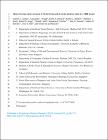| dc.contributor.author | Kemp, Andrew | |
| dc.contributor.author | Wright, Alexander | |
| dc.contributor.author | Edwards, Robin | |
| dc.contributor.author | Barnett, Robert | |
| dc.contributor.author | Brain, Matthew | |
| dc.contributor.author | Kopp, Robert | |
| dc.contributor.author | Cahill, Niamh | |
| dc.contributor.author | Horton, Benjamin | |
| dc.contributor.author | Charman, Dan | |
| dc.contributor.author | Hawkes, Andrea | |
| dc.contributor.author | Hill, Troy | |
| dc.contributor.author | van de Plassche, Orson | |
| dc.date.accessioned | 2019-01-15T13:44:03Z | |
| dc.date.available | 2019-01-15T13:44:03Z | |
| dc.date.issued | 2018 | |
| dc.date.submitted | 2018 | en |
| dc.identifier.citation | Andrew Kemp, Alexander Wright, Robin Edwards, Robert Barnett, Matthew Brain, Robert Kopp, Niamh Cahill, Benjamin Horton, Dan Charman, Andrea Hawkes, Troy Hill, Orson van de Plassche, 'Relative sea-level change in Newfoundland, Canada during the past ~3000 years', 2018, Quaternary Science Reviews;, 201;, 1 December 2018; | en |
| dc.identifier.other | Y | |
| dc.identifier.uri | http://hdl.handle.net/2262/85902 | |
| dc.description | PUBLISHED | en |
| dc.description.abstract | Several processes contributing to coastal relative sea-level (RSL) change in the North Atlantic Ocean are
observed and/or predicted to have distinctive spatial expressions that vary by latitude. To expand the
latitudinal range of RSL records spanning the past ~3000 years and the likelihood of recognizing the
characteristic fingerprints of these processes, we reconstructed RSL at two sites (Big River and Placentia)
in Newfoundland from salt-marsh sediment. Bayesian transfer functions established the height of former
sea level from preserved assemblages of foraminifera and testate amoebae. Age-depth models constrained
by radiocarbon dates and chronohorizons estimated the timing of sediment deposition. During
the past ~3000 years, RSL rose by ~3.0mat Big River and by ~1.5mat Placentia. A locally calibrated
geotechnical model showed that post-depositional lowering through sediment compaction was minimal.
To isolate and quantify contributions to RSL from global, regional linear, regional non-linear, and localscale
processes, we decomposed the new reconstructions (and those in an expanded, global database)
using a spatio-temporal statistical model. The global component confirms that 20th century sea-level
rise occurred at the fastest, century-scale rate in over 3000 years (P > 0.999). Distinguishing the contributions
from local and regional non-linear processes is made challenging by a sparse network of reconstructions.
However, only a small contribution from local-scale processes is necessary to reconcile RSL
reconstructions and modeled RSL trends. We identified three latitudinally-organized groups of sites that
share coherent regional non-linear trends and indicate that dynamic redistribution of ocean mass by
currents and/or winds was likely an important driver of sea-level change in the North Atlantic Ocean
during the past ~3000 years. | en |
| dc.format.extent | 89 | en |
| dc.format.extent | 110 | en |
| dc.language.iso | en | en |
| dc.relation.ispartofseries | Quaternary Science Reviews; | |
| dc.relation.ispartofseries | 201; | |
| dc.relation.ispartofseries | 1 December 2018; | |
| dc.rights | Y | en |
| dc.subject | sea level change | en |
| dc.title | Relative sea-level change in Newfoundland, Canada during the past ~3000 years | en |
| dc.type | Journal Article | en |
| dc.type.supercollection | scholarly_publications | en |
| dc.type.supercollection | refereed_publications | en |
| dc.identifier.peoplefinderurl | http://people.tcd.ie/edwardsr | |
| dc.identifier.rssinternalid | 192728 | |
| dc.identifier.doi | https://doi.org/10.1016/j.quascirev.2018.10.012 | |
| dc.rights.ecaccessrights | openAccess | |
| dc.subject.TCDTheme | Smart & Sustainable Planet | en |
| dc.subject.TCDTag | BENTHIC FORAMINIFERA | en |
| dc.subject.TCDTag | SALT-MARSH | en |
| dc.subject.TCDTag | SALTMARSH | en |
| dc.subject.TCDTag | relative sea-level change | en |
| dc.identifier.orcid_id | 0000-0002-9986-0136 | |
| dc.status.accessible | N | en |




